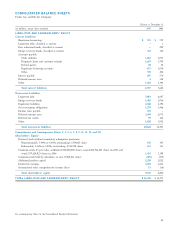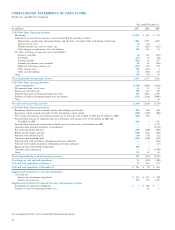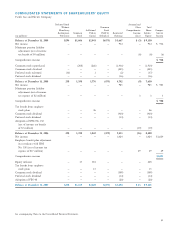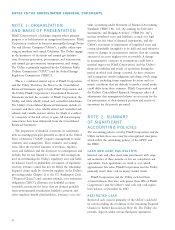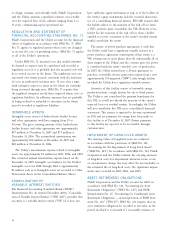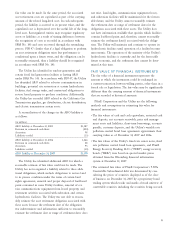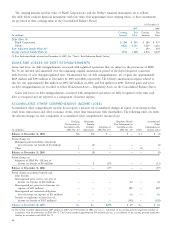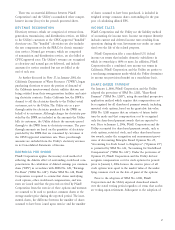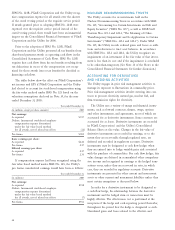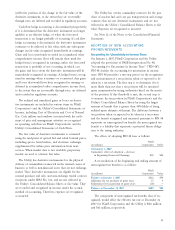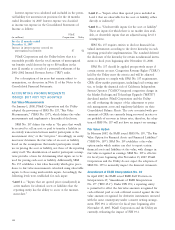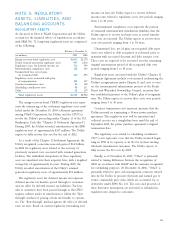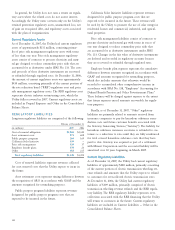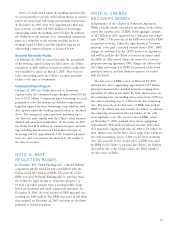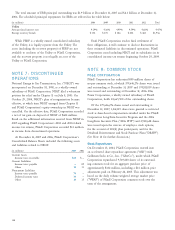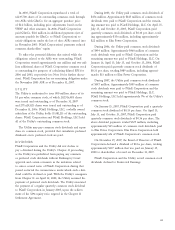PG&E 2007 Annual Report Download - page 101
Download and view the complete annual report
Please find page 101 of the 2007 PG&E annual report below. You can navigate through the pages in the report by either clicking on the pages listed below, or by using the keyword search tool below to find specific information within the annual report.
99
ineffective portions of the change in the fair value of the
derivative instrument, to the extent they are recoverable
through rates, are deferred and recorded in regulatory accounts.
Cash fl ow hedge accounting is discontinued prospectively
if it is determined that the derivative instrument no longer
qualifi es as an effective hedge, or when the forecasted
transaction is no longer probable of occurring. If cash fl ow
hedge accounting is discontinued, the derivative instrument
con tinues to be refl ected at fair value, with any subsequent
changes in fair value recognized immediately in earnings.
Gains and losses previously recorded in accumulated other
comprehensive income (loss) will remain there until the
hedged item is recognized in earnings, unless the forecasted
transaction is probable of not occurring, in which case
the gains and losses from the derivative instrument will be
immediately recognized in earnings. A hedged item is recog-
nized in earnings when it matures or is exercised. Any gains
and losses that would have been recognized in earnings or
deferred in accumulated other comprehensive income (loss),
to the extent they are recoverable through rates, are deferred
and recorded in regulatory accounts.
Net realized and unrealized gains or losses on deriva-
tive instruments are included in various items in PG&E
Corporation’s and the Utility’s Consolidated Statements of
Income, including Cost of Electricity and Cost of Natural
Gas. Cash infl ows and outfl ows associated with the settle-
ment of price risk management activities are recognized
in operating cash fl ows in PG&E Corporation’s and the
Utility’s Consolidated Statements of Cash Flows.
The fair value of derivative instruments is estimated
using the mid-point of quoted bid and asked forward prices,
including quotes from brokers, and electronic exchanges,
supplemented by online price information from news
services. When market data is not available, proprietary
models are used to estimate fair value.
The Utility has derivative instruments for the physical
delivery of commodities transacted in the normal course of
business as well as non-fi nancial assets that are not exchange-
traded. These derivative instruments are eligible for the
normal purchase and sales and non-exchange traded contract
exceptions under SFAS No. 133, and are not refl ected in
the Utility’s Consolidated Balance Sheets at fair value. They
are recorded and recognized in income under the accrual
method of accounting. Therefore, expenses are recognized
as incurred.
The Utility has certain commodity contracts for the pur-
chase of nuclear fuel and core gas transportation and storage
contracts that are not derivative instruments and are not
refl ected in the Utility’s Consolidated Balance Sheets at fair
value. Expenses are recognized as incurred.
See Note 12 of the Notes to the Consolidated Financial
Statements.
ADOPTION OF NEW ACCOUNTING
PRONOUNCEMENTS
Accounting for Uncertainty in Income Taxes
On January 1, 2007, PG&E Corporation and the Utility
adopted the provisions of FASB Interpretation No. 48,
“Accounting for Uncertainty in Income Taxes” (“FIN 48”).
FIN 48 clarifi es the accounting for uncertainty in income
taxes. FIN 48 prescribes a two-step process in the recognition
and measurement of a tax position taken or expected to be
taken in a tax return. The fi rst step is to determine if it is
more likely than not that a tax position will be sustained
upon examination by taxing authorities based on the merits
of the position. If this threshold is met, the second step is
to measure the tax position in PG&E Corporation’s and the
Utility’s Consolidated Balance Sheets by using the largest
amount of benefi t that is greater than 50% likely of being
realized upon ultimate settlement. The difference between a
tax position taken or expected to be taken in a tax return
and the benefi t recognized and measured pursuant to FIN 48
represents an unrecognized tax benefi t. An unrecognized tax
benefi t is a liability that represents a potential future obliga-
tion to the taxing authority.
The effects of adopting FIN 48 were as follows:
PG&E
(in millions) Corporation Utility
At January 1, 2007
Cumulative effect of adoption — decrease
to Beginning Reinvested Earnings $18 $20
A reconciliation of the beginning and ending amount of
unrecognized tax benefi ts is as follows:
PG&E
(in millions) Corporation Utility
Balance at January 1, 2007 $ 212 $ 90
Additions for tax position of prior years 15 4
Reductions for tax position of prior years (18) —
Balance at December 31, 2007 $209 $94
The component of unrecognized tax benefi ts that, if rec-
ognized, would affect the effective tax rate at December 31,
2007 for PG&E Corporation and the Utility is $110 million
and $63 million, respectively.


